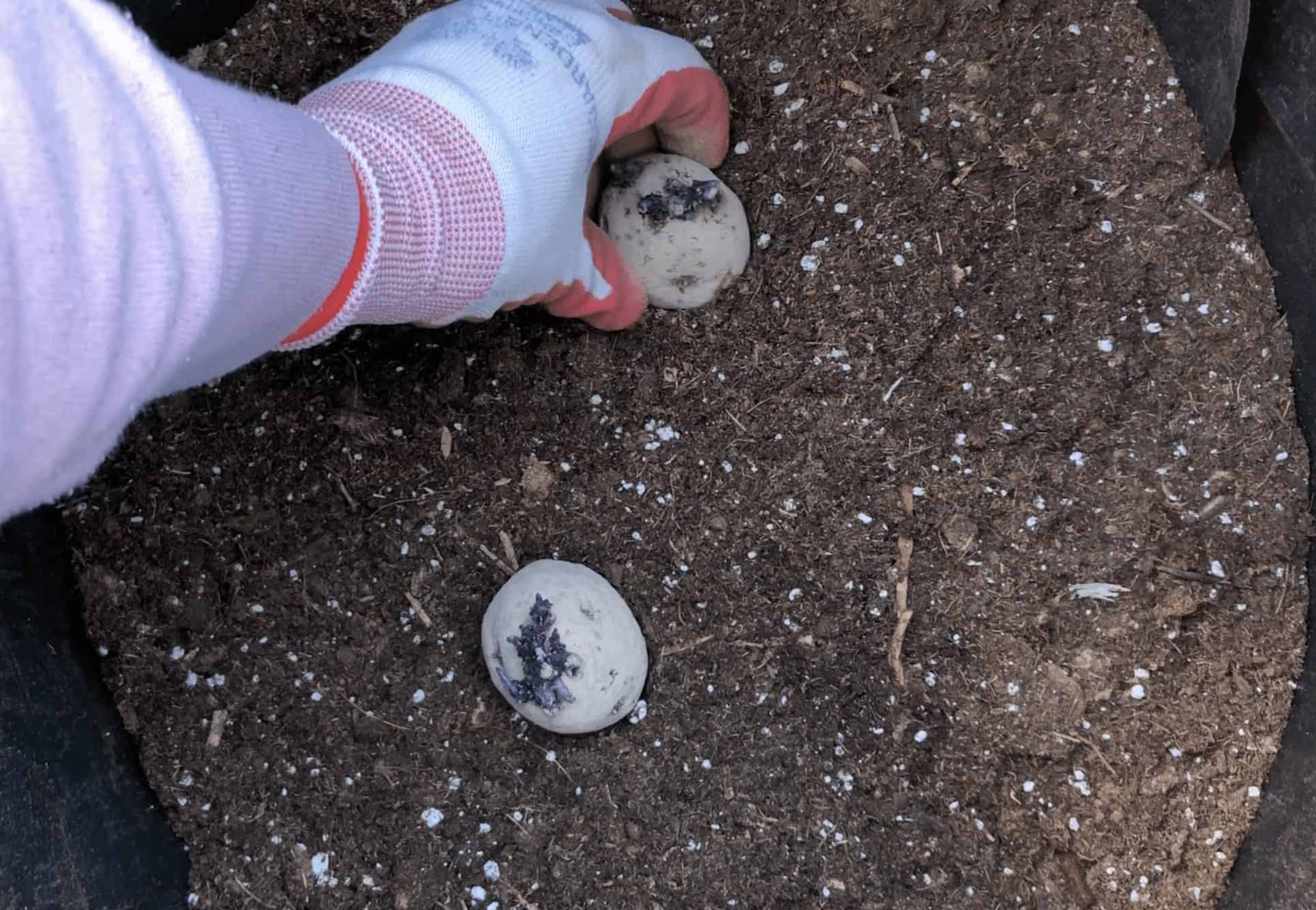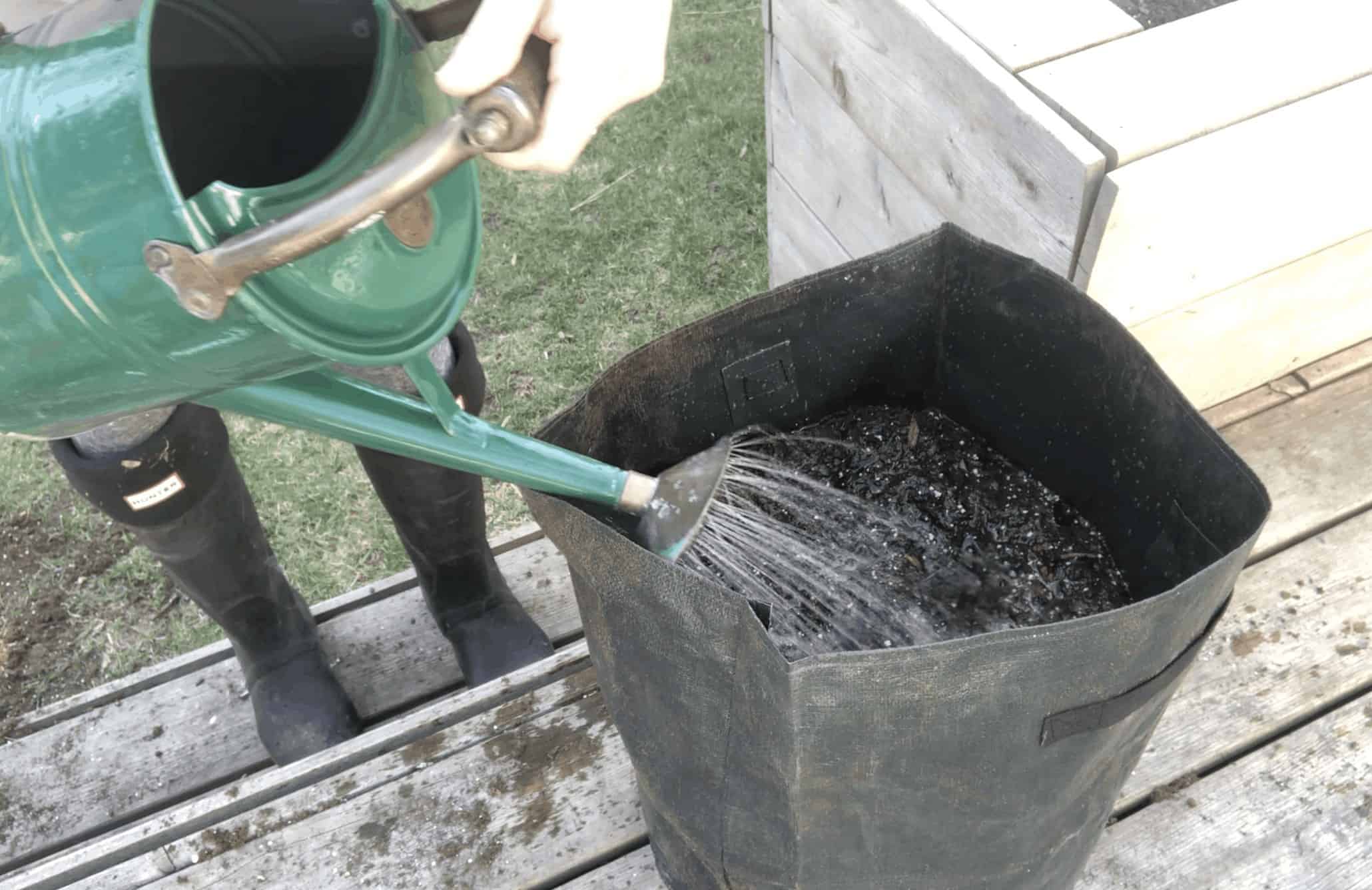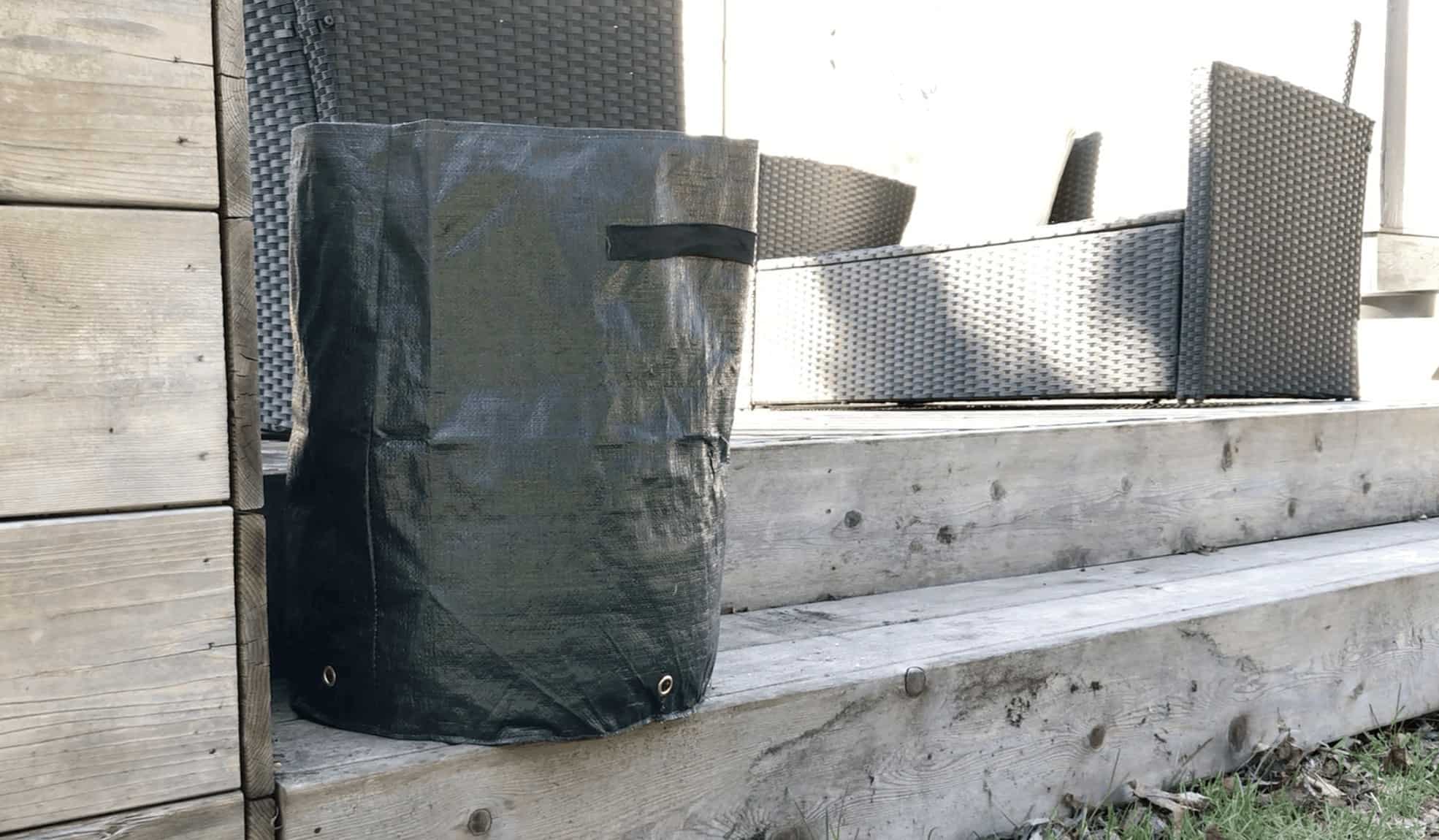Potato grow bags are typically 5-20 gallon fabric bags built specifically for growing potatoes. Some are made of non-woven geotextile, while others are made of a plastic tarp-like material with metal grommets for drainage holes. Some have little trapdoors on the side for harvesting. Seed potatoes are typically planted near the bottom of the grow bag, with soil added periodically as the stem grows upwards.
Potato grow bag basics
If you want to try your hand at growing potatoes, potato grow bags are a great option, whether or not you’re short on space. These bags are typically made from breathable fabric and/or have drainage holes to let out excess water.
Grow bags can be placed on a patio, balcony, or any other sunny spot. One of the benefits of using grow bags is that they can be easily moved around if necessary due to bad weather or in search of sunlight. Additionally, the fabric helps to aerate the soil and improve drainage, both of which are important for healthy potato growth.
Potato grow bags are also great because there is no digging to plant the seed potatoes and no digging in the fall to harvest the crop of potatoes. The process is easy for kids and new gardeners. It’s also great for small-space and balcony gardens. Many gardeners who have in-ground or raised bed gardens still choose to grow their potatoes in bags because it is so much easier to harvest the tubers in the fall.
Having used many different types, my favorite potato grow bags are these root pouch ones, which have lasted for years and always grow a good harvest. I also like Vivosun grow bags as a lower-cost option if you need quite a few bags. And I have not yet tried (but can’t wait for) the very cool new grow bags from Epic Gardening.
Choosing a potato grow bag
There are lots of different grow bags that work with potatoes. The smallest ones are 5 gallons and can fit one small seed potato. More reasonably-sized potato grow bags hold 10-15 gallons and are at least 20″ wide. Big potato grow bags can be 20 gallons or larger and can hold a few potato plants if so desired (although they can be tricky to move!).
My go-to potato grow bag is this 15L root pouch made from recycled plastic water bottles. It’s BPA-free and UV-resistant. It’s big enough that the potato plant has space to grow lots of roots but small enough I can move it around if required.
When selecting a potato grow bag, choose one large enough to accommodate the number of plants you want to grow. Also, be sure to check that the fabric is durable and breathable/can drain out water. Plastic tarp-like potato bags should have obvious drainage holes. Avoid bags that don’t drain very well.
Choosing seed potatoes to grow
You can grow any type of potato in a grow bag! Here are some yummy potato varieties to consider planting this season:
- Yukon Gold potatoes
- Kennebec potatoes
- Russet potatoes
- Norland potatoes
- Purple Majesty potatoes
- Red Pontiac potatoes
- German Butterball potatoes
- French Fingerling potatoes
How many seed potatoes per grow bag?
The number of seed potatoes that can be placed in a single grow bag depends on the size of the seed potatoes and the size of the grow bag. In general, 1-2 potato plants can fit in a smaller 5-10 gallon grow bag. For larger 15-20 gallon grow bags, you can put more like 3-4 plants if you have lots of seed potatoes and want to plant them all.
Some seed potatoes are small mini tubers that have only 2-3 “eyes” (sprouts) on them. These can be planted whole to create one potato plant. Larger seed potatoes are generally cut into smaller pieces with 2-3 eyes each. The pieces are left out for a couple of days so that the cuts can dry. Then each piece is planted separately to create individual potato plants.
Preparing seed potatoes for planting
Seed potatoes are usually left out to sprout, or “chit,” before planting. This helps them to grow more quickly once they are in the ground.
To chit, simply place seed potatoes in a egg carton or on a tray with the eyes pointing up if possible. Place them in a sunny spot and wait for them to sprout. Light and air helps to sprout/chit potatoes. Once the seed potatoes have sprouted to about an inch long, they can be planted in the grow bag.

How to plant potatoes in a grow bag
Potatoes can be planted in a grow bag by adding a little potting mix to the bottom, placing a seed potato or two on top of the soil base, adding a few more inches of soil, and watering deeply. You can roll back the sides of the bag to let the light in as the sprouts appear. Then keep adding soil when the sprout is about 6″ above the soil line until the bag is full.
Supplies
- Potato grow bag
- Seed potatoes
- Lightweight potting mix
- Potato fertilizer
- Trowel
- Water
“Potatoes are grown from “seed potatoes” – small potatoes held over from the previous season to plant the following year. While you can save your own seed potatoes, this risks transferring disease from one crop to the next. It’s better to buy fresh seed potatoes from a reputable supplier.”
GrowVeg: The Beginner’s Guide to Easy Vegetable Gardening, by Benedict Vanheems
Steps
1. Start with clean, disinfected hands and tools.
2. If using larger seed potatoes, cut them into 2-3″ pieces with 2-3 eyes each. Allow the cuts to dry for a few days before planting.
3. Fill the grow bag with 4″-6″ of a well-draining potting mix. Usually, the bag is about 1/3 full at this point.
4. Mix a bit of potato fertilizer into the potting mix.
5. Place the first seed potato on top of the mix. Place them with chits/eyes up. Potatoes have a top and bottom; the top/stem is the chit/sprout and the bottom/heel is where the mother plant’s root went in when the seed potato was a baby, like a potato belly button.
6. Add the additional seed potato(es) spacing them 6″-8″ apart if using larger pieces (if the bag allows). If planting whole mini tubers, you can space them about 4″-6″ apart (or evenly spaced). Put 1-2 tubers/pieces into smaller 5-10 gallon bags or 3-6 potatoes into larger 15-20 gallon bags.
Here’s a more detailed guide all about how to grow potatoes if you need more info.

7. Cover the seed potatoes with about 4″ of potting mix.
8. Roll the sides of the bag down so that the sunlight can reach the leaves when the potato sprout reaches the surface.
9. Place the grow bag in a sunny spot.
10. Water the grow bag thoroughly until water drains out of the bottom.

Caring for newly-planted potatoes
Here are the basics for caring for potatoes growing in bags after they’ve been planted.
1. Keep the soil moist but not soggy for the next few weeks (check that it’s draining). The yellow/green sprout should appear in 2-3 weeks.
2. When plants are 6″ tall, add more potting mix to the bag, being careful not to damage the potato plants.
3. Continue adding soil as the plants grow (like hilling up potato plants in the ground). Be sure to leave about 4″ of space from the top of the bag to the soil line. This helps prevent the potatoes from toppling over when they are ready to harvest.
4. Add a potato fertilizer according to package instructions when plants are 12″ tall.
5. When plants flower, stop adding soil and allow the potatoes to mature.

Harvesting bag-grown potatoes
Here are the basics for harvesting potatoes grown in a grow bag:
1. Get ready to harvest the potatoes when the plants begin to die back (turn brown and wilt). This usually happens about 3-4 months after planting (read more about how long potatoes take to grow).
2. Cut the yellowed aboveground foliage off the plants and discard them in the compost pile.
3. Carefully remove the potatoes from the grow bag, being careful not to damage them. You can either dig into the bag or topple it over and upend the bag so the soil and potatoes pour out. Either way is super-fun!
4. Leave the potatoes in a sunny spot to dry. Then brush off excess dirt.
5. Store in a cool, dark place until ready to eat.

Tips for caring for potatoes growing in bags
Potatoes will grow well in full light, but the plants also tolerate some shade. When potatoes are grown in some shade, expect a lesser yield and smaller tubers.
Cover with a cloth during slight frost, bring inside if it gets below freezing. If the initial shoots of seed potatoes are destroyed by frost, new ones may sprout.
In the spring, water once a week and much more frequently in the summer if it’s hot and dry out. Container potatoes should receive enough water but not be soggy.
Cover the smaller potatoes with earth after they’ve grown to about 6 inches tall and continue to cover the tiny plants until you reach the top of the bag.
Plant some chives, thyme, or other companion plants for potatoes in the soil once the maximum level has been reached. They’ll be a bit crowded when the potato plants leaf out (especially if lots of seed potatoes are planted), but they’re so nice to have right in your potato bag to harvest for fresh-baked potatoes topped with fresh herbs in the fall.
FAQs about growing potatoes in grow bags
Do potatoes grow well in grow bags?
Yes! Potato grow bags are a great option for new gardeners, kids, and those with small growing spaces (like a patio). Grow bags are easy to plant (no digging), easy to “hill up” (just add soil), and easy to harvest (just tip over the bag).
How many potatoes can you grow in a grow bag?
It depends on the size of the grow bag and the size of the potatoes. In general, 1-2 potato plants can fit in a smaller 5-10 gallon grow bag. For larger 15-20 gallon grow bags, you can put more like 3-4 plants.
What is the best size grow bag for potatoes?
In general, 15L is a nice size grow bag for potatoes, but you can grow them in smaller or larger grow bags too. The size of grow bag you will need depends on the amount of space you have and the amount you want to grow. Be sure to select a size that can comfortably accommodate all of your plants but won’t be too heavy for you to move if needed.
Resources
Here are some helpful resources for your while learning how to grow potatoes:
- Get my free garden planner here!
- Want garden tips, updates, and freebies? Sign up for my newsletter
- My favorite things for the vegetable garden
- Visit my shop
- Watch my YouTube playlist about growing annual veggies
References
GrowVeg: The Beginner’s Guide to Easy Vegetable Gardening, by Benedict Vanheems
More vegetable plants for your garden
Wondering what else would thrive in your garden? Check out these posts about vegetable gardens!






